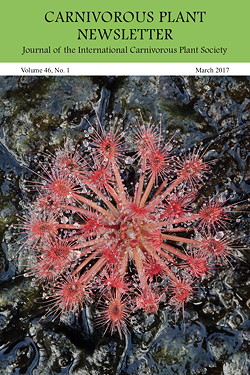International Carnivorous Plant Society
Carnivorous Plant Newsletter Archive
Many triggerplants (Stylidium spp.; Stylidiaceae) form arbuscular mycorrhizal associations
Stephen P. Moberly and Maxine Watson and Douglas W. Darnowski
Carniv. Pl. Newslett. 46(1):23-27
Published 24 February 2017
https://doi.org/10.55360/cpn461.sm240
Summary
Triggerplants (Stylidium spp.; Stylidiaceae) grow in Australia and a few areas to its north, though >95% of the >300 species in the genus Stylidium are endemic to Australia. Their name comes from the extremely rapid, active, and resettable pollination mechanism which they use. In addition, they have been recently recognized as possessing at least some of the traits of carnivorous plants, specifically the ability to trap and digest prey insects, as well as the more recently-demonstrated ability to transport and, therefore, benefit, from nutrients obtained in that way. Generally, they trap prey which are much smaller than their pollinators. Triggerplants typically are found in extremely nutrient poor conditions where genera such as Drosera and Utricularia are usually found in the same places.
Keywords: triggerplant, Stylidium, AM-fungi, mycorrhizae, carnivorous
Article Citation
Stephen P. Moberly and Maxine Watson and Douglas W. Darnowski. 2017. Many triggerplants (Stylidium spp.; Stylidiaceae) form arbuscular mycorrhizal associations. Carniv. Pl. Newslett. 46(1):23-27. https://doi.org/10.55360/cpn461.sm240
Page views: 1131
©2025 International Carnivorous Plant Society
www.carnivorousplants.org
This page is maintained by John Brittnacher.
Please contact us at our membership website, icps.clubexpress.com.
Privacy: The Carnivorous Plant Newsletter Archive website does not track users.

